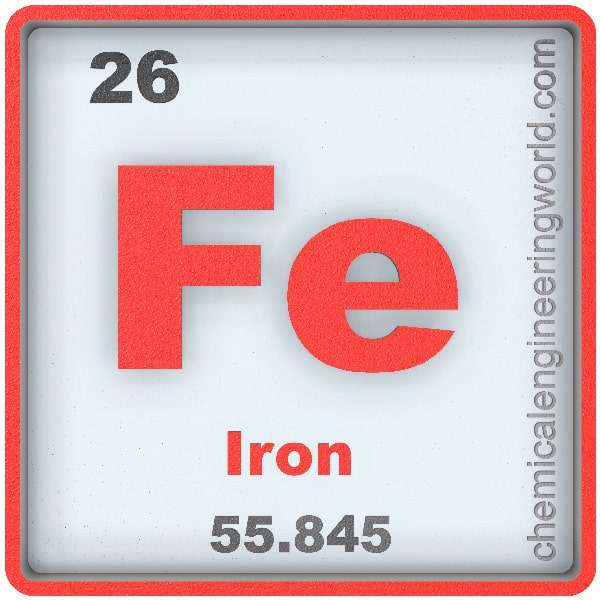Iron Element Properties and Information

Iron Element Properties and Information
Iron is the twenty-sixth element on the periodic table. Elements are arranged in the periodic table on the basis of the atomic number. Atomic number is the number of protons in the nucleus of the atom. Iron has an atomic number of 26. It is located in the Group 8 and Period 4 of the periodic table of elements. It is denoted by Fe. The name is derived from its Anglo-Saxon name ‘Iren’.
René Antoine Ferchault de Réaumur was the first person to write a book in 1772 which explains various types of iron. Iron objects have been found in Egypt dating 3500 BC. The ancient Hittites of Asia Minor (modern day Turkey) where the first to smelt iron from its ores around 1500 BC.
Iron is the most abundant element on Earth by mass. It is the fourth most abundant element inside the Earth’s crust. The core of the earth is assumed to be composed mostly iron. Iron is a quite widely distributed metal. Major iron ore is haematite, other iron containing ores are magnetite, taconite, etc.
Physical Properties
- Iron has a shining grey luster. Pure iron is soft in nature.
- The atomic mass of iron is 55.85
- The melting point of iron is 1536°C
- The boiling point of iron is 2861°C
- The density of iron is 7800 in S.I. units at 20°C
- Iron has four stable isotopes; ferrous-54, ferrous-56, ferrous-57, and ferrous-58. The ferrous-56 amounts to 91.754% of total ferrous.
Chemical Properties
- Iron shows characteristics of transition metals because it forms very large coordination and organic compounds.
- Iron pyrite is also called as fool’s gold because it looks like gold in outer appearance.
- Iron reacts with fluorine, chlorine, and bromine to form ferric halides. Ferric chloride is the most common among them. Ferric iodide is thermodynamically unstable because of high oxidising power of ferric ions and high reducing power of iodide ions.
- Ferrate(VI) anion is an extremely strong oxidiser. It oxidises nitrogen and ammonia at room temperature and also water in neutral or acidic solutions.
Methods of Production
- Main industrial process: The major route of manufacturing metallic iron commercially consists of two major steps; first is reduction of iron ore and the second is oxidation of the product obtained from the first step. For the first step, the iron ore and coke are charged in blast furnace. Air at the temperature of 900°C is charged through the mixture, enough air is charged to convert carbon to carbon monoxide in sufficient amounts. The heat released due to conversion raises the overall temperature to 2000°C. At this temperature, carbon monoxide reduces iron ore to metallic iron. Resulting product is not pure, it contains 4-5% of carbon hence it is called pig iron. Oxidation of pig iron is performed in the second step to lower the carbon content and to yield wrought iron, steel, and cast iron.
- Direct iron reduction: The iron ore is directly reduced into a form known as sponge iron which can be directly used for steel making. First methane is partially oxidised with heat and catalysts to produce a mixture of carbon monoxide and hydrogen gases and then iron ore is reacted with these gases in a furnace to produce a solid sponge iron.
Thermite process: The iron oxide is mixed with aluminium powder and then ignited to produce metallic iron and aluminium oxide. The reaction produces enormous heat, the temperature rises to about 4000°C.
Relevance in Chemical and Related Industries
- Catalysts: Iron catalysts are widely used in chemical and related industries. For example; they are used in Haber-Bosch process for the production of ammonia, in the Fisher-Tropsch process for conversion of carbon monoxide to hydrocarbons, in Bechamp Reduction process for the reduction of nitrobenzene to aniline.
- Water purification: Iron(III) chloride is used in water purification and also in sewage treatment.
Relevance in Other Industries
Structures: Iron is used in all metals. 90% of all metals produced in the world is iron. Iron has low cost and high strength. It is used in automobiles, rails, ship hulls, machining tools, etc. The load carrying framework of buildings is majorly supported by iron.
Health Effects on Exposure
- Deficiency: Iron is an important constituent for the proper functioning of human body. Deficiency of iron causes anemia.
- Accumulation: If iron contacts and accumulates in the tissues then it causes conjunctivitis, choroiditis, and retinitis.
- Inhalation: Inhaling iron oxide fumes or dusts causes benign pneumoconiosis, it causes no physical impairement to lungs but long time exposure increases the risk of development of lung cancer.
Effects on Surroundings
- Accumulation: Iron gets easily accumulated in surroundings, in water and lands. Many compounds of iron can be hazardous to environment, especially to water bodies and plants.
References:
https://en.m.wikipedia.org/wiki/Iron
































